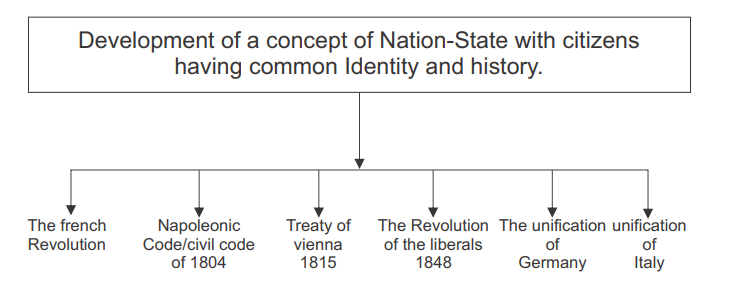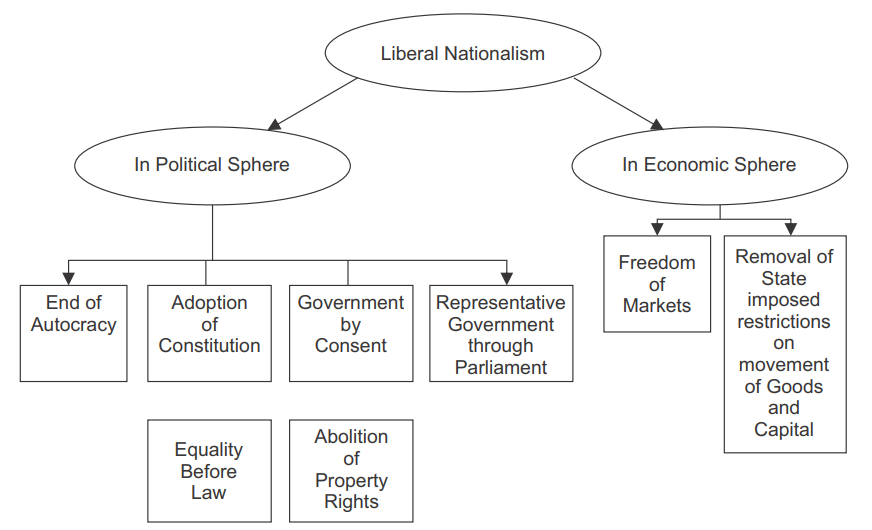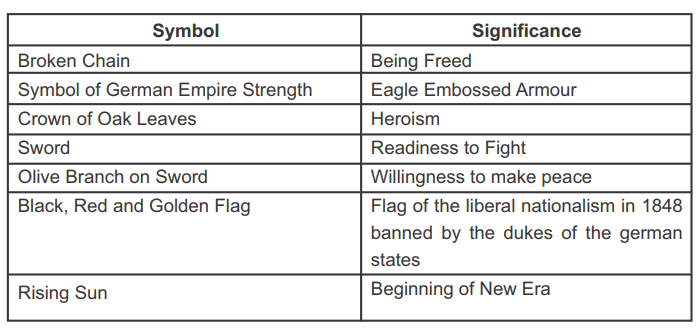Concepts


- Monarchy is a political system in which supreme authority is vested in the monarch, an individual ruler who functions as head of state.
- Nationalism: is a political ideology that promotes the idea of democracy with loyalty and devotion to a nation.
- The Rise of Nationalism in Europe: Frédéric Sorrieu, a French artist, in 1848, prepared a series of four prints, visualising his dream of a world made up of democratic and Social Republics.
- The first print shows the people of Europe and America marching in a long train and offering homage to the Statue of Liberty as they pass it. The torch of Enlightenment was carried by a female figure in one hand and the Charter of the Rights of Man in the other.
- On the earth in the foreground lie the shattered remains of the symbols of absolutist institutions.
- In Sorrieu’s utopian vision, the people of the world are grouped as distinct nations, identified through their flags and national costume.
- The procession was led by the United States and Switzerland, followed by France and Germany. Following the German people are the people of Austria, the Kingdom of the Two Sicilies, Lombardy, Poland, England, Ireland, Hungary and Russia.
- From the heavens above, Christ, saints and angels gaze upon the scene. They have been used by the artist to symbolise fraternity among the nations of the world.
During the nineteenth century, nationalism emerged as a force which brought huge changes in the political and mental world of Europe. The end result of these changes was the emergence of the nation-state.
The French Revolution and the Idea of the Nation
- In 1789, Nationalism came with the French Revolution and the political and constitutional changes led to the transfer of sovereignty from the monarchy to a body of French citizens. Various measures and practices were introduced, such as the ideas of la patrie (the fatherland) and le citoyen ( the citizen). A new French flag, the tricolour, was chosen to replace the former one.
- Democracy was destroyed in France by Napoleon, and the Civil Code of 1804, known as the Napoleonic Code, did away with all privileges based on birth, established equality before the law and secured the right to property.

The Making of Nationalism in Europe
Germany, Italy and Switzerland were divided into kingdoms, duchies and cantons whose rulers had their autonomous territories.
The Aristocracy and the New Middle Class
The Aristocracy was the dominant class on the continent politically and socially. The majority of the population was made up of the peasantry. Industrialisation began in England in the second half of the eighteenth century. New social groups came into being: a working-class population and a middle class made up of industrialists, businessmen, and professionals.
What Did Liberal Nationalism Stand For?
- The term ‘liberalism’ derives from the Latin root liber, meaning free. The right to vote and to get elected was granted exclusively to property-owning men. Men without property and all women were excluded from political rights.
- In 1834, a customs union or Zollverein was formed at the initiative of Prussia and joined by most of the German states. The union abolished tariff barriers and reduced the number of currencies from over thirty to two.
A New Conservatism after 1815
- In 1815, European governments were driven by a spirit of conservatism. Conservatives believed in monarchy, the Church, social hierarchies, and property and that the family should be preserved.
- A modern army, an efficient bureaucracy, a dynamic economy, and the abolition of feudalism and serfdom could strengthen the autocratic monarchies of Europe.
- In 1815, representatives of the European powers – Britain, Russia, Prussia and Austria met in Vienna to draw up a settlement for Europe.
- The Bourbon dynasty was restored to power, and France lost the territories it had annexed under Napoleon.
- The major issue taken up by the liberal nationalists, who criticised the new conservative order, was the freedom of the press.
The Revolutionaries
- In 1815, secret societies were formed in many European states to train revolutionaries and spread their ideas. Revolutionaries opposed monarchical forms and fought for liberty and freedom.
- The Italian revolutionary Giuseppe Mazzini, born in Genoa in 1807, founded two more underground societies, the first being Young Italy in Marseilles.
- Secondly, he founded Young Europe in Berne, whose members were like-minded young men from Poland, France, Italy and the German states.
The Age of Revolutions: 1830-1848
In July 1830, Bourbon Kings were overthrown by liberal revolutionaries who installed a constitutional monarchy with Louis Philippe at its head. The July Revolution sparked an uprising in Brussels which led to Belgium breaking away from the United Kingdom of the Netherlands. In 1821, Greeks struggled for independence.
The Romantic Imagination and National Feeling
- Culture played an important role in creating the idea of the nation: art and poetry, stories, and music helped express and shape nationalist feelings.
- Romanticism was a cultural movement which sought to develop a particular form of nationalist sentiment. Language also played an important role in developing nationalist sentiments.
- The Russian language was imposed everywhere, and in 1831, an armed rebellion against Russian rule took place, which was ultimately crushed.
Hunger, Hardship and Popular Revolt
Europe faced economic hardships in the 1830s. The first half of the nineteenth century saw an enormous increase in population all over Europe. The rise of food prices or a year of bad harvest led to widespread pauperism in towns and countries. In 1848, food shortages and widespread unemployment brought the population of Paris out on the roads.
The Revolution of the Liberals
In 1848, a revolution led by the educated middle classes was underway. Men and women of the liberal middle class demanded the creation of a nation-state on parliamentary principles – a constitution, freedom of the press and freedom of association.
A large number of political associations came together in Frankfurt to vote for an all-German National Assembly. On 18 May 1848, 831 elected representatives marched to take their places in the Frankfurt parliament convened in the Church of St Paul.
The Constitution drafted for the German nation was headed by a monarchy, subject to a Parliament. The Crown was offered to Friedrich Wilhelm IV, King of Prussia, but he rejected it and joined other monarchs to oppose the elected assembly. The Middle Class dominated the Parliament, and a large number of women participated in the liberal movement.
Women formed their own political associations, founded newspapers and took part in
political meetings and demonstrations, but they were still denied suffrage rights during the election of the Assembly.
In the years after 1848, the autocratic monarchies of Central and Eastern Europe began to introduce the changes that had already taken place in Western Europe before 1815. Thus, serfdom and bonded labour were abolished both in the Habsburg dominions and in Russia.
The Making of Germany and Italy
Germany – Can the Army Be the Architect of a Nation?
Nationalism in Europe moved away after 1848, and Germany and Italy came to be unified as nation-states. Prussia took over the leadership of the movement for national unification. The architect of this process was its chief minister, Otto von Bismarck, and it was carried out with the help of the Prussian army and bureaucracy.
In January 1871, the Prussian King, William I, was proclaimed German Emperor. An assembly was held to proclaim the new German Empire. The process of nation-building demonstrated the dominance of Prussian state power. The currency, banking, legal and judicial systems in Germany were modernised.

Italy Unified
Italy was divided into seven states in the middle of the nineteenth century, and among all the seven states, Sardinia-Piedmont was ruled by an Italian princely house. All the regions were dominated by different kings. In the 1830’s Giuseppe Mazzini formed a secret society called Young Italy.
The movement was led by Chief Minister Cavour. In 1859, Sardinia-Piedmont defeated Austrian forces. In 1860, they marched into South Italy and the Kingdom of the Two Sicilies and succeeded in winning the support of the local peasants. In 1861 Victor Emmanuel II was proclaimed king of united Italy.
The Strange Case of Britain
Great Britain was the model of the nation, and prior to the eighteenth century, there was no British nation. The nation became powerful as it steadily grew in wealth, importance and power.
The Act of Union (1707) between England and Scotland resulted in the formation of the ‘United Kingdom of Great Britain’ meant, in effect, that England was able to impose its influence on Scotland. In 1801, Ireland was forcibly incorporated into the United Kingdom. The symbols of the new Britain – the British flag (Union Jack), the national anthem (God Save Our Noble King), and the English language – were actively promoted.
Visualising the Nation
In the eighteenth and nineteenth centuries, artists represented a country as a person and nations as female figures. During the French Revolution, female figures portray ideas such as Liberty, Justice and the Republic. Liberty is represented as a red cap or the broken chain, and justice as a blindfolded woman carrying a pair of weighing scales.
Nationalism and Imperialism
Nationalism was no longer retained after the last quarter of the nineteenth century. After 1871, the most tensioned area was called the Balkans, a region comprising modern-day Romania, Bulgaria, Albania, Greece, Macedonia, Croatia, Bosnia-Herzegovina, Slovenia, Serbia and Montenegro.
Ottoman Empire made the Balkans region explosive, and all through the nineteenth century, they strengthened themselves through modernisation and internal reforms. Due to various conflicts, Balkan became an area of intense conflict.
During this period, intense rivalry built among the European powers over trade and colonies as well as naval and military might, which led to a series of wars in the region and, finally, the First World War.
In 1914, Europe was disastered because of Nationalism, aligned with imperialism. Anti-imperial movements were developed, but they all struggled to form independent nation-states. But the idea of ‘nation-states’ was accepted as natural and universal.
Major events
- In the 18th century Germany, Italy, Switzerland was divided into many states and each had an independent ruler.
- French Revolution It was the first expression of nationalism. It ended monarchy in France and gave power to the citizens.
- Napoleonic code of 1804: It did away with all privileges based on birth, established equality before the law and secured the right to property.
- Revolutionary France mark the first political experiment in liberal democracy, the right to vote and to get elected was granted exclusively to property owning men. Men without property and all women were excluded from political rights only for a brief period under the Jacobins did all adult males enjoy right to vote however 'The Napoleonic code' went back to limited suffrage and reduced women to the status of a minor , subject to the authority of father's and husband's.
- Vienna Congress in 1815: representatives of the European powers - Britain, Russia, Prussia and Austria - who had collectively defeated Napoleon, met at Vienna to draw up a settlement for Europe. The Congress was hosted by the Austrian chancellor Duke Metternich.
- In January 1871, the Prussian king, William I, was proclaimed German Emperor in a ceremony held at versailles.
- In 1861 Victor Emmanuel II was proclaimed king of united Italy.
- Women had form their own political associations, founded newspapers and taking part in political meeting and demonstrations. Despite this they were denied suffrage right during the election of the assembly.
Important terms
- Absolutist - Literally, a government or system of rule that has no estraints on the power exercised. in history, the term refers to a form of monarchical government that was centralised, militarised and epressive.
- Utopian - Avision of a society that is so ideal that it is unlikely to actually exist.
- Plebiscite -Adirect vote by which all the people of a region are asked to accept or reject a proposal.
- Conservatism - A political philosophy that stressed the importance of tradition, established institutions and customs, and preferred gradual
development to quick change. - Zollverein was formed at the initiative of Prussia and joined by most of the German States. The union abolished tariff barriers and reduce the number
of currencies from over thirty to two. - Romanticism - A cultural movement which sought to develop a particular form of Nationalist sentiment.
- Liberalism derived from the Latin root liber meaning free.
- Junkers - Important personalities and Large landowners of Prussia.
Important Personalities
- Mazzini - Mazzini is known for his noble efforts to achieve the unification of Italy. he is regarded as the spiritual force behind the Italian unification.
he started the movement known as the Young Italy. He inspired the youths of not only Italy but of whole Europe to fight for freedom. - Garibaldi - He is known as the physical force or the Sword of Italy. He, with Mazzini launched the young Italy movement for the unification of
Italy. He involved The sardinian sailors to Revolt in 1835 A.D. - Cavour- The real credit for the unification of Italy goes to cavour, who became the Prime Minister of sardinia in 1852 A.D. He, then dedicated
himself, his body and soul together, to achieve his goal of independence and unification of Italy. - Bismarck - He played the most important role in the unification of Germany, his policy of blood and iron was mainly responsible.
Meaning of symbols


